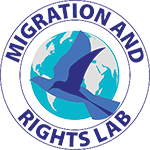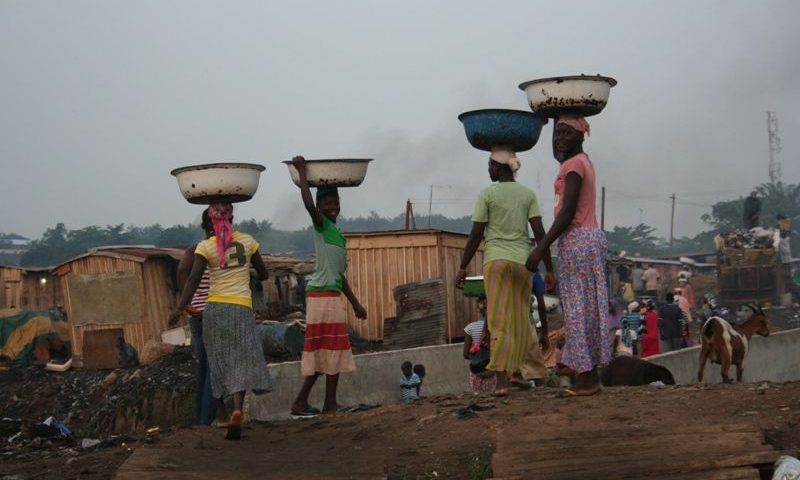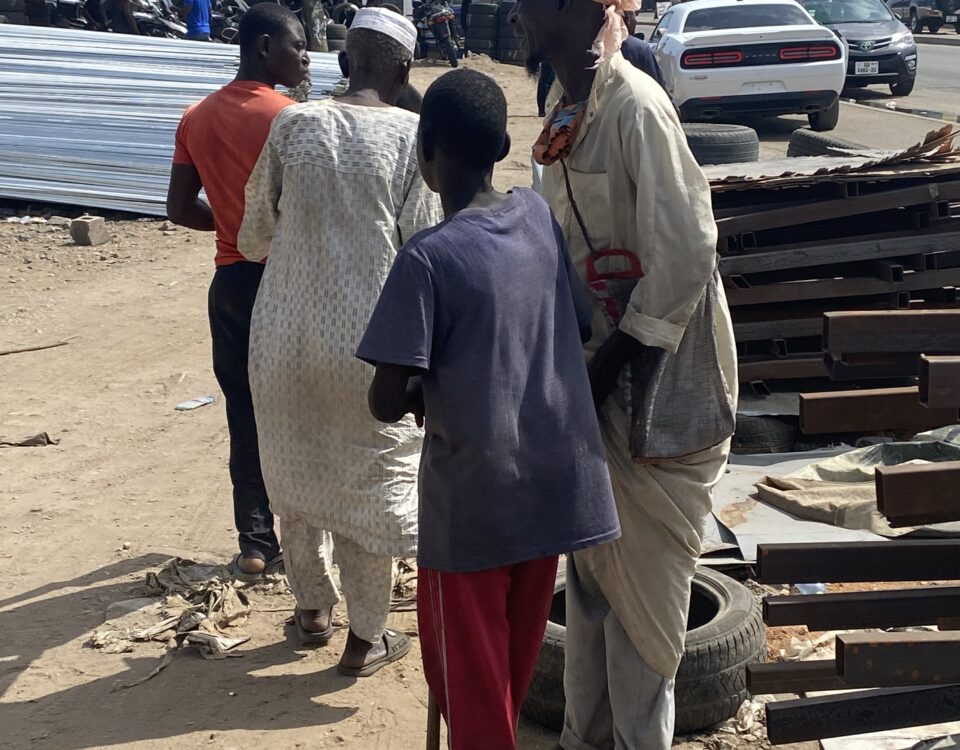Kayayei: A Consequence of Inadequate Family Support and Government Policy Failure

Baby Harvesting and Trafficking in Health Care in Ghana.
January 22, 2021
Development of Training Modules and Pilot Training of Stakeholders on Right to Decent Work and Forced Labour
November 17, 2021Sylvester Kyei-Gyamfi et al.
This paper examines the causes, effects and situations of children engaged in ‘kaya’ business, the role and significance of the family as a social institution to protect children from engaging in kaya, the initiatives put in place by the government of Ghana, and the way forward for addressing the phenomenon. A brief history of migration trends in the country is provided at the beginning of the paper zeroing in on the current high migration movements of young girls from the north to the south of the country to engage in ‘kaya’.Brief insights are also given on the role and significance of the Ghanaian family in providing family care to children. A cursory assessment of the capacity of the Ministry of gender, Children and Social Protection (MoGCSP) to manage the phenomenon has alsobeen done, and suitable recommendations made to address the problem in question. A desk study approach was mainly utilized for the compilation of this paper.
Migration has always been a livelihood strategy for most migrants in developing countries, as a result, labour migrants form the bulk of the migration stock in this part of the globe ((Ratha et al., 2016). Disparities in social and economic development between origin and destination areas to a large extent account for most of migration (Ratha et al., 2016). For developing countries such as Ghana, rural–urban migration is mostly common, and it results from developmental policies adopted during the colonial and post-colonial era (Abdul-Korah, 2011; Mabogunje, 1990; Pickbourn, 2011).The focus of government policies during this era was on industrial development of urban cities with the import of labour from the rural areas to work in the mines and on cash crop farms, among others. Government also committed huge investments to developing the south of the country, leaving the north with barely any a major investment, and deepening imbalances between thesetwo areas(Nabila, 1975; Kwankye et al, 2007;Songsore, 2009; Van der Geest, 2011). The practice therefore created developmental and resources disparities and inequalities not only between rural and urban areas but also between the northern and the southern (Abdul-Korah, 2011).This phenomenon has adversely impacted on family incomes and wellbeing as most families in the rural north became poor as a result of the lack of decent livelihoods, making it difficult for them to support their families (Awumbila et al., 2014). Thus, the occurrence of internal migration in Ghana was occasioned bythe inequalities created by government policies at the time. The stage for rural-urban migration was subsequently set,as many household heads moved in search of better social services, infrastructure, and decent livelihoods to enable them take care of themselves and their families. This has been the pattern of internal migration over the past decades. These patterns are a reflection of regional disparities and differential rural-urban poverty in the country (MOI, 2014; GSS, 2014).
It is important to note that the family has a crucial role in ensuring the survival, protection and development of every individual, including the child, and as result has a huge task in making sure children do not migrate.Family is defined as a group of people related by blood, marriage, law (in the case of adoption), common identity as well as lineage and ethnic group (Government of Ghana, 2014). Distinction is sometimes drawn between a nuclear family, which is typically defined as a family group that consist of only mother, father and children, and the extended family, which is typically defined as a family that includes near relatives in addition to the nuclear family (Government of Ghana, 2014). In Ghana, the extended family for many years has been the traditional unit of society in Ghanaian communities, providing social and economic security to various family members in times of need. This system has an in-built safety net, which provides for the care of children within the family (MoGCSP, 2013). In other words, the system rests on a customary assumption that each person within the family is another’s keeper; everyone is helped by another person and it goes round in circles to help other family members in the future. The system encourages well-to-do members to take care of less endowed and vulnerable members within the family(MoGCSP, 2013).Among most ethnic groups in Ghana including those in the north, it is usually the responsibility of uncles to take care of their nephews and nieces, in the absence of their biological parents or when these parents are in financial difficulty. However, according to So (1990), the structure of the traditional family has been altered by contemporary global practices.
The extended family has shrunk into nuclear families with a less complicated structure hence it being unable to carry-out its expected roles (Assimeng, 1999; Nukunya, 2003; Therborn, 2004).Thus, the emergence of modern systems through social change and the promotion of economic growth, and other pressures from urbanization have contributed to a gradual decline and nucleating of the extended family system (Assimeng, 1999; MoGCSP, 2013; Nukunya, 2003).This is partly due to the fact that many families havein the recent past become urbanized, moving from rural communities to urban communities and in the process shifting the focus to providing for the needs of nuclear families instead of the external family thereby making it difficult for poor family members to support their own.The lack of support from both the extended and nuclear families, and the lack of job opportunities have compelled a huge number of young people to migrate in search of jobs in the southern parts of the country (Anarfi, Kwankye. et al. 2003). The large number of young people who migrate independently from the north to the south,including young women and girls, have migrated to become head porters and engage in other informal ventures such as petty trading. They have come to be referred to as “Kayayei”, (Awumbila and Schandorf, 2008:171). The word kayayoo was derived from two languages that are commonly spoken in major markets in Accra.Kaya comes from the Hausa language, meaning luggage, load or goods, and Yoo is a Ga wordmeaning a woman. The word kayayoo, is a combination of the two words, meaning a young woman or a teenage girl who carries other people’s loads on the head for a fee. The plural form of yoo is yei, hence kayayeiare women head porters. Because such women are ubiquitous in the towns and cities of southern Ghana, the terms kayayoo and kayayeihave become part of the Ghanaian commercial vocabulary (Opare, 2003)
A common migration trend in Ghana is the constant rise in migration of young women from economically deprived areas in Ghana into the cities and commercial centres (Abdul-Korah, 2011). These are mostly young women and girls with little or no formal education who move independent of their families from rural agricultural communities in the north to urban centres in the south to work in the informal sector. They work in the low scale economic bracket, mostly unskilled occupations such as the Kayayei. The conveyance of loads from one point to the other in typically major markets, is their primary occupation(Awumbila and Ardayfio-Schandorf, 2008). This however does not mean that all Kayayei working in southern Ghana are from the northern part of the country (Opare, 2003).Official statistics from Ghana Statistical Service indicate that about 90 percent of all migration in Ghana is internal (GSS, 2013). The Ghana Living Standards Survey (GLSS 5) and the 2010 Population Census likewise suggest that internal migrants constitute over 50 percent of the Ghanaian population, and close to half of this proportion are women (Ackah & Medvedev, 2010; Ghana Statistical Services, 2013). Despite the rise in independent female migration and its attendant consequences (Adepoju, 2010), this trend of migration has received less research and policy recognition compared to other forms of migration. Studies posit that internal migration of young women will continue to increase as long as the driving forces of this occurrence still remain unattended (IOM, 2014). Nonetheless, the exact figure of children engaged in the Kaya business in Ghana is not known. This is because there has not been any national census conducted on the phenomenon (MoGCSP, 2014). Again, quantifying this phenomenon in Ghana has proved difficult due to the mobile nature of these children.This explains the inconsistencies in the projections of the number of children involved. In 2003, the Catholic Action for Street Children (CAS) estimated that there are more than 20,000 street[1]involved children in Accra, the capital city (CAS, 2003). An NGO, The Peoples Dialogue and the Ghana Federation of Urban Poor (PDGFUP) also estimated the number of Kayayei around 15,000 (PDGFUP, 2011). The PDGFUP study also found that 92 percent of all kayayei sampled were from the three northern Regions of Ghana.According to Kwankye et al (2009), only a very small part of the Kayayei come from other parts, includingsurrounding southern areas. In a statement by the Hon. Minister of Gender Children and Social Protection to Parliament(MoGCSP, 2014), she indicated that all the statistics and projections available in the country show that most Kayayei are migrants from the northern parts of Ghana. These projections seem to confirm the assertion that kayayei is a migration related phenomenon.


